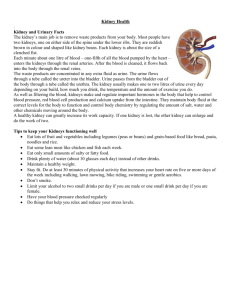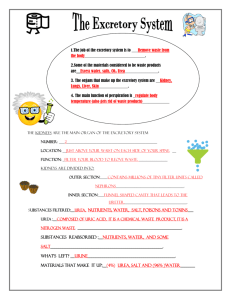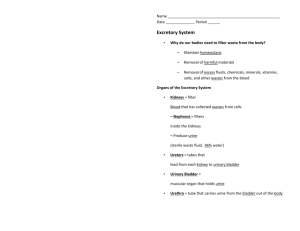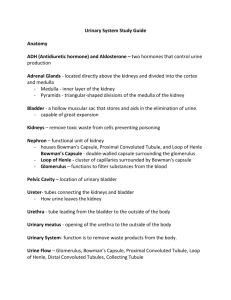chapter 11-the urinary system
advertisement
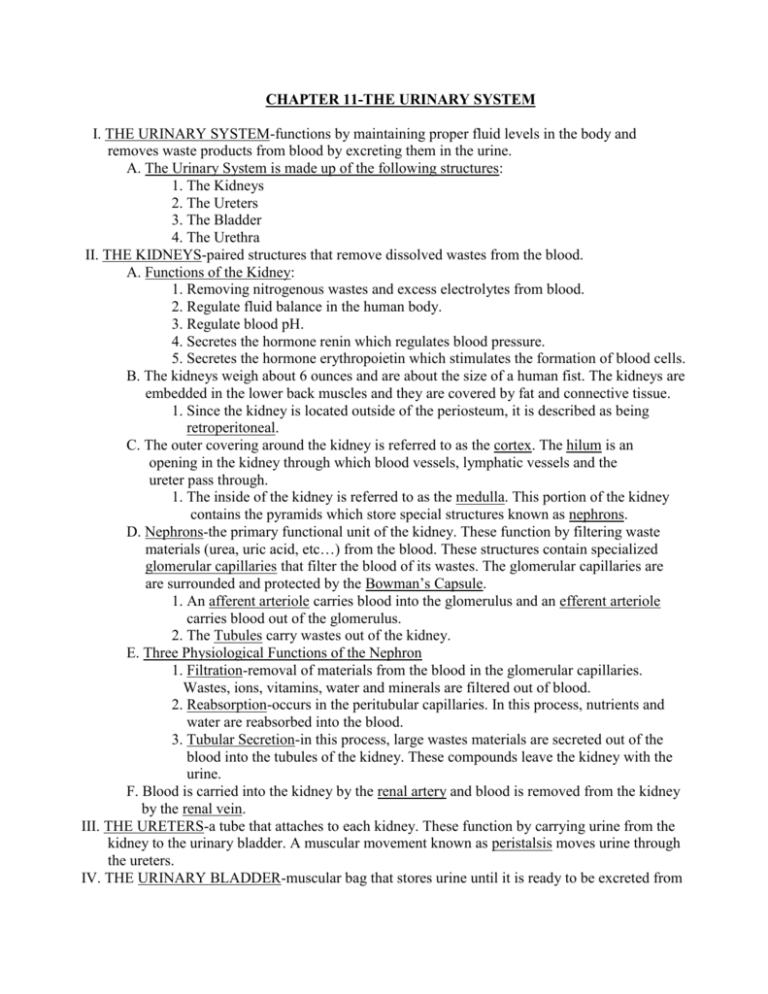
CHAPTER 11-THE URINARY SYSTEM I. THE URINARY SYSTEM-functions by maintaining proper fluid levels in the body and removes waste products from blood by excreting them in the urine. A. The Urinary System is made up of the following structures: 1. The Kidneys 2. The Ureters 3. The Bladder 4. The Urethra II. THE KIDNEYS-paired structures that remove dissolved wastes from the blood. A. Functions of the Kidney: 1. Removing nitrogenous wastes and excess electrolytes from blood. 2. Regulate fluid balance in the human body. 3. Regulate blood pH. 4. Secretes the hormone renin which regulates blood pressure. 5. Secretes the hormone erythropoietin which stimulates the formation of blood cells. B. The kidneys weigh about 6 ounces and are about the size of a human fist. The kidneys are embedded in the lower back muscles and they are covered by fat and connective tissue. 1. Since the kidney is located outside of the periosteum, it is described as being retroperitoneal. C. The outer covering around the kidney is referred to as the cortex. The hilum is an opening in the kidney through which blood vessels, lymphatic vessels and the ureter pass through. 1. The inside of the kidney is referred to as the medulla. This portion of the kidney contains the pyramids which store special structures known as nephrons. D. Nephrons-the primary functional unit of the kidney. These function by filtering waste materials (urea, uric acid, etc…) from the blood. These structures contain specialized glomerular capillaries that filter the blood of its wastes. The glomerular capillaries are are surrounded and protected by the Bowman’s Capsule. 1. An afferent arteriole carries blood into the glomerulus and an efferent arteriole carries blood out of the glomerulus. 2. The Tubules carry wastes out of the kidney. E. Three Physiological Functions of the Nephron 1. Filtration-removal of materials from the blood in the glomerular capillaries. Wastes, ions, vitamins, water and minerals are filtered out of blood. 2. Reabsorption-occurs in the peritubular capillaries. In this process, nutrients and water are reabsorbed into the blood. 3. Tubular Secretion-in this process, large wastes materials are secreted out of the blood into the tubules of the kidney. These compounds leave the kidney with the urine. F. Blood is carried into the kidney by the renal artery and blood is removed from the kidney by the renal vein. III. THE URETERS-a tube that attaches to each kidney. These function by carrying urine from the kidney to the urinary bladder. A muscular movement known as peristalsis moves urine through the ureters. IV. THE URINARY BLADDER-muscular bag that stores urine until it is ready to be excreted from the body. The bladder has a triangular shape referred to as a trigone where the two ureters enter and the urethra exits. A. The bladder is able to stretch and it can hold up to 400 ml of urine. B. Rugae-folds in the bladder, allow the bladder to expand beyond its original shape. V. THE URETHRA-a tube that connects the bladder to the outside of the body. It is composed primarily of smooth muscle and epithelial tissue. VI. URINE FLOW OUT OF THE BODY: A. Filtrate forms in the glomerulus. B. This material travels through the tubules of the kidney. Nutrients and water are reabsorbed by the peritubular capillaries at this point. C. Large wastes are secreted into the tubules via tubular secretion. D. This material, known as urine, passes into the collecting duct and eventually exits the kidney via the ureter. E. Urine travels through the ureter to the urinary bladder. From here, urine passes through the urethra to exit the body. VII. COMBINING FORMS, SUFFIXES, PREFIXES-pages 357-358. VIII. PATHOLOGY A. Pyelonephritis B. Glomerulonephritis C. Nephrolithiasis D. Acute Tubular Necrosis IX. DISEASES/CONDITION/PROCEDURES-pages 361-371. X. PHARMACOLOGY-pages 371-372.





